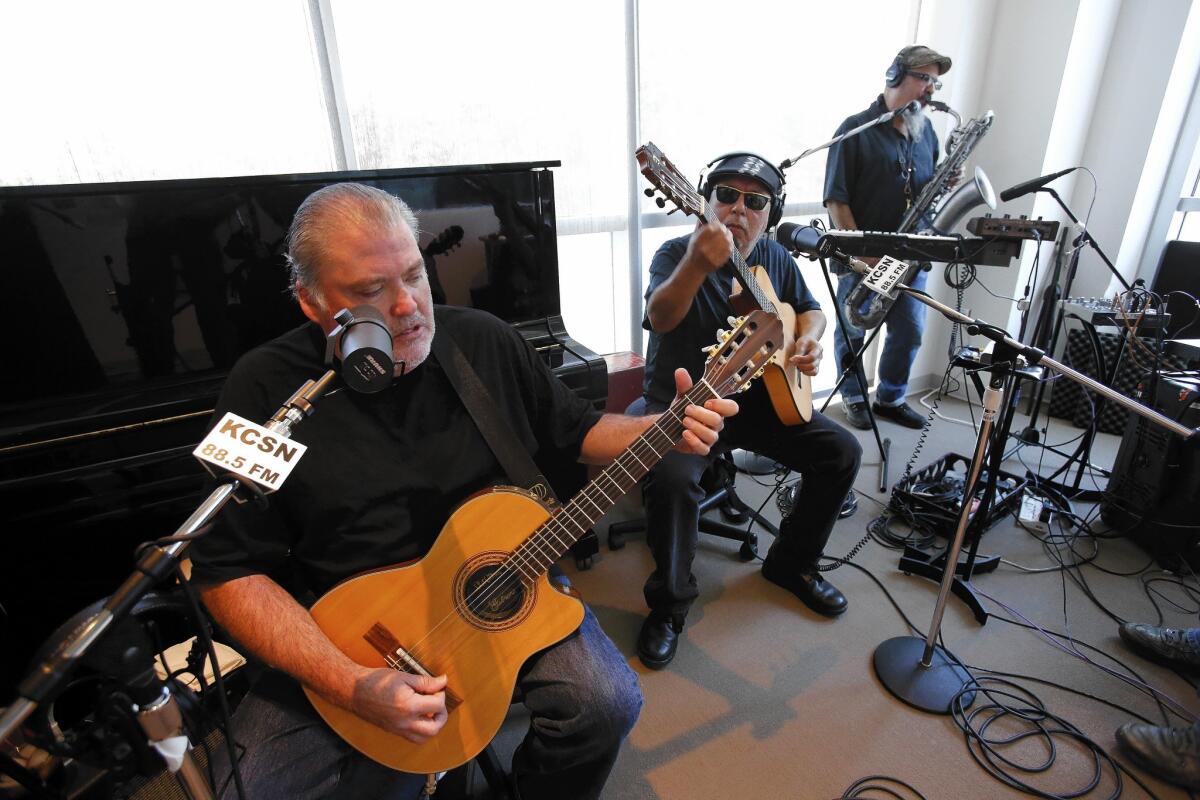CSUN’s KCSN HD2 station bilingual format in tune with its listeners

Listeners tuning in to KCSN’s new HD2 radio station will notice something once unheard of but increasingly common in American culture: Spanish and English being spoken — and sung — together, almost interchangeably.
One day recently, for example, the Cal State Northridge public radio station played “Hypnotized,” an erotically chill trip-hop track by the British band Morcheeba, sung in English, with Chile’s Ana Tijoux adding a Spanish-language rap.
A quarter-hour later, KCSN fired up “Cinco Minutos Con Vos” (Five Minutes With You), an elegiac dub/neo-soul tune by Elvis Costello and the Roots, performed mainly in English but with a haunting Spanish-language guest vocal by Marisoul of the red-hot L.A. band La Santa Cecilia, a 2014 Grammy nominee.
PHOTOS: Celebrity portraits by The Times
On all but a handful of radio stations, as in the vast majority of network television shows and Hollywood movies, English and Spanish are still strictly segregated. But by launching its new “Latin alternative” music format, KCSN seeks to blur that barrier and cater to young U.S. Latinos, as well as a growing number of non-Latinos, who regularly consume pop culture in two or more idioms.
The public, nonprofit station bills itself as the country’s first English-language radio channel to play progressive Latin music around the clock. CSUN officials believe the big question isn’t so much whether their format will succeed, but why no one had tried it before. The new station launched Nov. 8 with a live in-studio performance by Los Lobos, the paragon of bilingual alt-rock bands.
“I find it uncanny,” says Sky Daniels, the public radio station’s up-tempo general manager. “No one in this market serves any modern Latin musical tastes. I mean, you have norteña formats, you have pop formats. But you don’t have a 24-7.”
KCSN’s new radio station resembles other recent initiatives by U.S. media outlets to attract 18- to 34-year-old Latinos by programming Latin-centric content that’s spoken in English, Spanish or, in some cases, a free-flowing combination of both. Fox News Latino, ESPN Deportes and the just-launched Fusion entertainment and news cable network, a joint venture of Disney/ABC television network and Univision Communications Inc., all are attempting to reach young, assimilated Latinos, a demographic much-coveted by advertisers.
PHOTOS: Concert photos by The Times
By adopting HD technology, KCSN hopes to match its content with a delivery system that will allow it to reach that demographic more easily.
HD Radio is a digital broadcast that’s “embedded” into the analog AM or FM radio signal, creating a static-free sound similar to that of satellite radio. HD channels reside on the dial just a fraction above or below their AM and FM analog siblings.
According to iBiquity Digital Corp., the Maryland-based company that holds the HD Radio trademark, 28 automobile brands, comprising 148 different models, currently offer HD radio technology or have announced that they will.
PHOTOS: Behind the scenes of movies and TV
More than 2,100 U.S. radio stations are equipped with HD Radio technology, including Pasadena-based KROQ (106.7 FM). Last year, the music news website the Top reported that iBiquity has developed working prototypes of HD-equipped mobile phones.
Marketing research repeatedly has shown that young Latinos, one of the country’s fastest-growing demographics, have tended to bypass laptops in favor of accessing the Web on less-expensive mobile devices.
“There’s 40,000 kids that go here — they never look up,” Daniels says, referring to CSUN’s student population, which is 40% Latino. “They have their smartphone, they have either their earphones or headphones. And they’re navigating without looking up, and they’re listening to mobile entertainment.”
Daniels says it’s still too early for KCSN to commission a survey to see how the new format is faring.
“Latin alternative” is a slippery term that encompasses several genres, including Latin alternative rock, electronic dance music, indie pop, rock en Español and fusions of salsa, soul, funk and Caribbean dance rhythms. A number of L.A. radio stations occasionally play some, or all, of these genres, but mostly on one- or two-hour weekly programs. Meanwhile, Southern California’s Spanish-language programming is dominated by talk radio, commercial pop and rock, and traditional regional music such as ranchera and norteña.
CSUN officials are backing the new HD2 station (which also live-streams at https://www.LatinAlt.org) for a number of reasons, including the school’s large Mexican American and Central American student population.
“This university, 20 years ago, 25 years ago, was by and large white,” says Cynthia Rawitch, CSUN’s vice provost and interim dean of arts, media and communications. “This is not who we are, and the radio station that claims to be CSUN’s radio station should reflect that diversity.”
CSUN regards the new format as a university and community resource that could help attract outside funding to support it. KCSN’s regular FM station, 88.5, will continue to broadcast a mix of progressive and indie rock, a format known as Triple-A (adult album alternative), with specialty programs in bluegrass and other genres.
“I could put a slammin’ hip-hop station, an outlaw hip-hop station, on and there’d be a lot of the kids on the campus that would love it,” Daniels says. “But it really isn’t the kind of station that from a university standpoint you could put forward as a community service.”
The new station also will provide opportunities for CSUN’s 873 journalism students, 390 of whom identify as Latino. KCSN intersperses its music programming with regular news updates and a half-hour evening news show that journalism students report, write, edit and host.
Linda Bowen, director of CSUN’s journalism department, says that the school’s bilingual broadcast journalism students want to be able to forge future careers in either English, Spanish or both. The new HD2 station, she says, gives them that training.
“Being bilingual is valued, and valuable, if not in the whole United States then certainly in the part of the United States we currently are in,” Bowen says.
About two years ago, KCSN gave the new Latin alternative format a trial run when it began airing a one-hour, nationally syndicated music program, “The Latin Alternative,” on Thursday evenings on its regular FM channel. The show, which originated and is produced out of WEXT (97.7 FM) in Albany, N.Y., now airs on more than 30 stations coast to coast.
It’s hosted, in English, by Josh Norek, vice president of business affairs and digital relations for North Hollywood-based Nacional Records, and Ernesto Lechner, author of the book “Rock en Español: The Latin Alternative Rock Explosion,” and a journalist who has contributed to The Times.
The one-hour show’s playlists, including such artists as Café Tacuba, Bajofondo and Zoé, have provided a template for the new 24-7 station. A number of these artists record on the scrappy indie Nacional label, which has gained a reputation as a pioneer in promoting progressive Latin music. Recently, radio stations in Panama and Colombia also have picked up the one-hour show.
Although Norek currently picks the music that airs on KCSN’s 24-7 channel, more of that responsibility gradually will shift to the students.
Norek says that, just as more non-Latino rock and pop musicians are incorporating Latin textures into their songs, growing numbers of non-Latino listeners are being drawn to Spanish-accented music. Although audiences in places like Duluth, Minn., and Decorah, Iowa, where “The Latin Alternative” airs, may not catch every topical reference or colloquialism, Norek says, they’re becoming attuned to new cultural sensibilities.
That’s especially true of places like Los Angeles, he adds. “The non-Latinos in Los Angeles have had so much more exposure to Latino culture to begin with. They call them the Latinized gringos.”
More to Read
The biggest entertainment stories
Get our big stories about Hollywood, film, television, music, arts, culture and more right in your inbox as soon as they publish.
You may occasionally receive promotional content from the Los Angeles Times.







